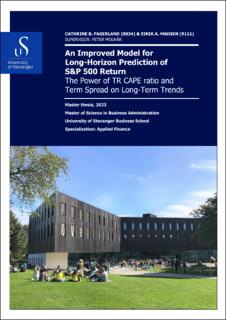| dc.description.abstract | In this paper we contribute to the literature of long-horizon predictions by constructing an
improved OLS regression model of S&P 500 return. The research of Robert Shiller has found
the Total Real Cyclically Adjusted Price Earnings (TR CAPE) ratio to be the optimal predictor
of the real long-term return of the S&P 500. Campbell Harvey found that the Term Spread,
how investors price the long-term bonds relative to the short-term bill contains valuable
information about impeding financial conditions. Due to the upside of fixed income being
inherently limited by the face value, the bond market does not have the same tendency to be
overly optimistic about the future. This makes the Term Spread a robust supplementation to
the equity market when estimating future growth. Our model uses the logarithm of TR CAPE
ratio and the Term Spread as independent variables, and the 10-year annualized Total Real
Return of S&P 500 as the dependent variable. We found that adding Term Spread to the original
TR CAPE model improves the model’s explanatory power by 9 percentage points, from 0.295
to 0.394. Leading us to conclude that the Term Spread adds complementary information, not
priced in by the equity market when predicting long-term returns. Our approach underscores
the importance of long-term trends from both the equity and bond market when predicting long-term return of the S&P 500. | |
